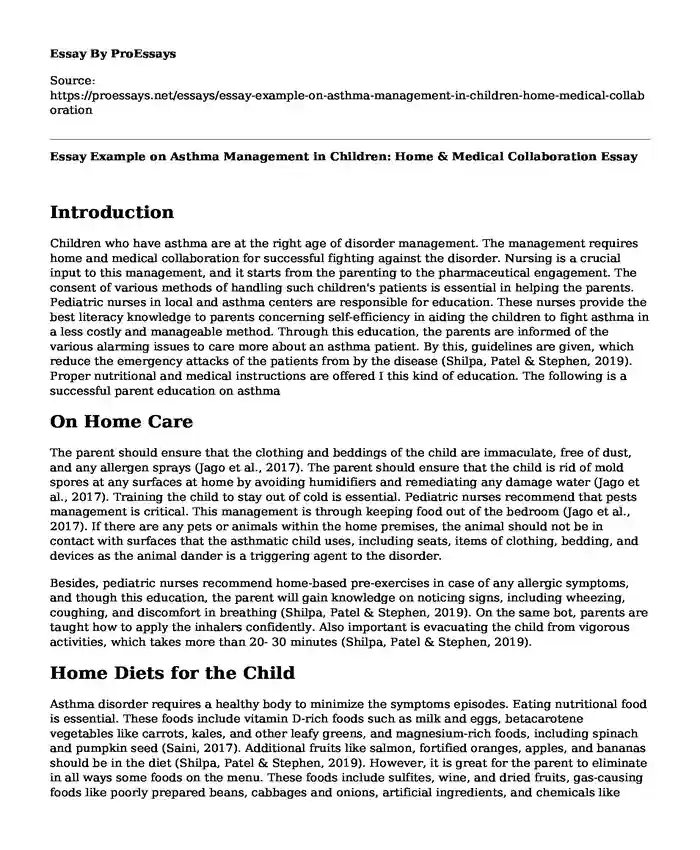Introduction
Children who have asthma are at the right age of disorder management. The management requires home and medical collaboration for successful fighting against the disorder. Nursing is a crucial input to this management, and it starts from the parenting to the pharmaceutical engagement. The consent of various methods of handling such children's patients is essential in helping the parents. Pediatric nurses in local and asthma centers are responsible for education. These nurses provide the best literacy knowledge to parents concerning self-efficiency in aiding the children to fight asthma in a less costly and manageable method. Through this education, the parents are informed of the various alarming issues to care more about an asthma patient. By this, guidelines are given, which reduce the emergency attacks of the patients from by the disease (Shilpa, Patel & Stephen, 2019). Proper nutritional and medical instructions are offered I this kind of education. The following is a successful parent education on asthma
On Home Care
The parent should ensure that the clothing and beddings of the child are immaculate, free of dust, and any allergen sprays (Jago et al., 2017). The parent should ensure that the child is rid of mold spores at any surfaces at home by avoiding humidifiers and remediating any damage water (Jago et al., 2017). Training the child to stay out of cold is essential. Pediatric nurses recommend that pests management is critical. This management is through keeping food out of the bedroom (Jago et al., 2017). If there are any pets or animals within the home premises, the animal should not be in contact with surfaces that the asthmatic child uses, including seats, items of clothing, bedding, and devices as the animal dander is a triggering agent to the disorder.
Besides, pediatric nurses recommend home-based pre-exercises in case of any allergic symptoms, and though this education, the parent will gain knowledge on noticing signs, including wheezing, coughing, and discomfort in breathing (Shilpa, Patel & Stephen, 2019). On the same bot, parents are taught how to apply the inhalers confidently. Also important is evacuating the child from vigorous activities, which takes more than 20- 30 minutes (Shilpa, Patel & Stephen, 2019).
Home Diets for the Child
Asthma disorder requires a healthy body to minimize the symptoms episodes. Eating nutritional food is essential. These foods include vitamin D-rich foods such as milk and eggs, betacarotene vegetables like carrots, kales, and other leafy greens, and magnesium-rich foods, including spinach and pumpkin seed (Saini, 2017). Additional fruits like salmon, fortified oranges, apples, and bananas should be in the diet (Shilpa, Patel & Stephen, 2019). However, it is great for the parent to eliminate in all ways some foods on the menu. These foods include sulfites, wine, and dried fruits, gas-causing foods like poorly prepared beans, cabbages and onions, artificial ingredients, and chemicals like food- flavors and colors (Saini, 2017).
Other Parental Measures Include:
- It is worth for a parent to create a plan and stick to it. The plan may include nutritional programs and clothing of the child as per the environment (Saini, 2017).
- The parent must adhere to prescriptions by the pharmacist (Saini, 2017).
- Create a habit child checkup, including a night check and asking questions to the child and trigger elimination (Saini, 2017).
- Ensure timely vaccination of flu to the child and other medical inventions (Saini, 2017).
- Use tools appropriately were required- these tools include inhalers and warmers (Saini, 2017).
- Equip the family members with the conducive checklist of flare-ups (Saini, 2017).
- Lastly, know what action to take in case of episodes and flare-ups at any time (Saini, 2017).
References
Jago, R., Searle, A., Henderson, A. J., & Turner, K. M. (2017). Designing a physical activity intervention for children with asthma: a qualitative study of the views of healthcare professionals, parents and children with asthma. BMJ open, 7(3).
Saini, B. (2017). Parents' asthma information needs and preferences for home-based asthma support. Journal of Asthma, 54(9), 946-956.
Shilpa J. Patel and Stephen J. Teach Pediatrics in Review November 2019, 40 (11) 549-567. https://pedsinreview.aappublications.org/content/40/11/549#:~:text=Diagnosis,a%20SABA%20likely%20has%20asthma.
Cite this page
Essay Example on Asthma Management in Children: Home & Medical Collaboration. (2023, Sep 10). Retrieved from https://proessays.net/essays/essay-example-on-asthma-management-in-children-home-medical-collaboration
If you are the original author of this essay and no longer wish to have it published on the ProEssays website, please click below to request its removal:
- Oppositional Defiant Disorder Trauma in Foster Children
- Why Are Personal Affiliation and Networking Necessary for a Nursing Leader?
- Essay Sample on Nutrition and Obesity
- Pathophysiology of Hemodynamics - Essay Sample
- Essay Example on Optimizing Shift Exchange for Nurses: SIPOC Method
- Paper Example on The Attribution Theory: A Real-World Guide to Health Sector Performance
- Scope of Practice for APRNs in New York and California: A Legislative Review - Free Paper Example







